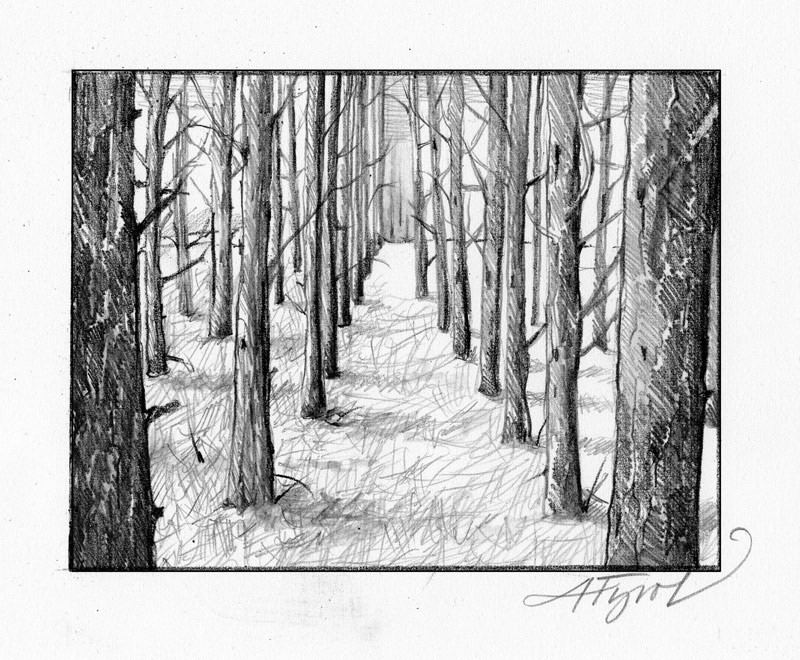
There’s an artificial quality to a red pine plantation that you don’t find elsewhere in Vermont and New Hampshire, a vibe that stems from the fact that all the trees were put there, by people, deliberately. Whereas an uneven-aged hardwood forest offers an organic mosaic of layers and life; whereas a regrowing clearcut provides a chaotic testament to ‘survival of the fittest’ – tree whips locked in mortal combat with one another as they strain with almost palpable tension towards the sun; the red pine plantation offers an orderly testament to man’s geometric spirit – the biological equivalent of a cemetery or a trailer park.
Many ecologists find plantations distasteful. Nature thrives on disorder, and so these sterile, planned environments are marked by a lack of plant and animal diversity. Many red pine plantations were planted a bit too claustrophobically back in the day, and the deep shade limits both the health of the trees and the plant life on the forest floor. Over time, fallen pine needles form a deep duff layer, further limiting the ability of other species’ seeds to germinate.
One could also resent the trees based on their lack of value. While well-formed, mature red pine is coveted, overcrowded plantation pine is not. Most wood-savvy landowners, if given a choice, would prefer dense stands of spruce, hemlock, cedar, really any softwood to red pine. If white pine – the King’s pine – evokes stately ship masts and wide plank flooring, red pine evokes telephone poles slathered up in creosote. It’s just not a sexy softwood.
Still, many a humble barn has been built from rough-cut red pine lumber, and ecological limitations aside, there’s something endearing about these stands. They’re often quiet, dark places – maybe not as somber as a hemlock or spruce grove, but still contemplative enough. Poets can point out that the forest looks disarrayed from most angles until you step into a row and the trees suddenly reorganize themselves into perfect lines – a marked burst of clarity in an otherwise haphazard landscape.
How did these plantations come to be in a place where foresters don’t typically plant forests? Sixty two thousand men worked for the Civilian Conservation Corps in Vermont and New Hampshire between 1933 and 1942, and they planted hundreds of thousands – if not millions – of red pine seedlings that became the trees we see today. (Nationwide, CCC crews planted 3 billion trees, though not all red pine). The government further subsidized red pine seedlings throughout the twentieth century as a way of providing hill farmers with a future cash crop that would grow on otherwise played-out soil. Red pine seemed the perfect candidate for this, as it’s fast growing and susceptible to fewer serious enemies than most pine species. (White pine can be bedeviled by white pine weevil and white pine blister rust – neither of which affect red pine.)
In retrospect, the “cash” part of “cash crop” proved a bit optimistic on most sites, and today, many of these plantations are coming down as landowners seek to either improve the value of their timber stock or improve the value of their wildlife habitat (unless they’re managing exclusively for red squirrels).
I’m keeping a small corner of the red pine plantation on my own woodlot intact as a nod to history, and I’m releasing a few pole-quality specimens to flourish, but the rest is scheduled to be aggressively thinned, a thinning that probably won’t generate much, if any, profit. In the meantime, my family and I have been felling, limbing, and peeling some logs to use as cabin poles. This time of year, the bark is relatively easy to remove with a bark spud, as the tree’s cambium is slimy with sap and ooze. When the tree stops growing in autumn, the dry cambium will bond to the wood and stripping the bark will be near impossible.
After the saws stop whining on our woodlot, peeling the cabin logs becomes quiet, meditative work. Despite the summer sun, it’s cool under the heavy forest cover; the fallen pine smells nice. At the end of the day, the stripped logs lie in naked repose, pale and shining upon the forest floor. Light filters through the holes in the canopy above, and it’s easy to imagine the next generation of seedlings that will soon spring forth to seize their own 70-year moment in the sun.


Discussion *